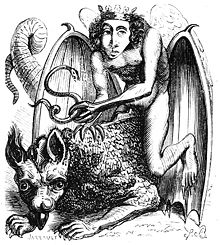Astaroth
This article has multiple issues. Please help improve it or discuss these issues on the talk page. (Learn how and when to remove these messages)
|


Astaroth (also Ashtaroth, Astarot and Asteroth), in demonology, is the Great Duke of Hell in the first hierarchy with Beelzebub and Lucifer; he is part of the evil trinity. He is a male figure most likely named after the Mesopotamian goddess Ishtar.
Background
The name Astaroth was ultimately derived from that of 2nd millennium BCE Phoenician goddess Astarte,[1] an equivalent of the Babylonian Ishtar, and the earlier Sumerian Inanna. She is mentioned in the Hebrew Bible in the forms Ashtoreth (singular) and Ashtaroth (plural, in reference to multiple statues of her). This latter form was directly transliterated in the early Greek and Latin versions of the Bible, where it was less apparent that it had been a plural feminine in Hebrew.
The pseudepigraphal work Testament of Solomon, traditionally attributed to Solomon of the United Monarchy, but thought to date to the early centuries CE, mentions "Asteraoth" (in Greek) as an angel, who is opposed to the demon of power (cf. 1 Kings 11:4–5).
Appearances in literature
The name "Astaroth" as a male demon is first known from The Book of Abramelin, purportedly written in Hebrew c. 1458, and recurred in most occult grimoires of the following centuries. Astaroth also features as an archdemon associated with the qliphoth (adverse forces) according to later Kabbalistic texts.
Dutch demonologist Johann Weyer also described Astaroth in his Pseudomonarchia Daemonum (1577) thus: "Astaroth is a great and a strong duke, coming forth in the shape of a foul angel, sitting upon an infernal dragon, and carrying on his right hand a viper", who also claimed to rule 40 legions. Also, he had to be approached by the conjurer with a magical ring on account of his stinking breath.[2] He is similarly referred to in the 17th-century work The Lesser Key of Solomon.
According to some demonologists of the 16th century, August is the month during which this demon's attacks against man are stronger. According to Sebastien Michaelis, he is a demon of the First Hierarchy, who seduces by means of laziness, self-doubt, and rationalized philosophies. His adversary is St. Bartholomew, who can protect against him for he has resisted Astaroth's temptations. To others, he teaches mathematical sciences and handicrafts, can make men invisible and lead them to hidden treasures, and answers every question formulated to him. He was also said to give to mortal beings the power over serpents.
According to Francis Barrett (c. 1801), Astaroth is the prince of accusers and inquisitors. In art, in the Dictionnaire Infernal (1818), Astaroth is depicted as a nude man with feathered wings, wearing a crown, holding a serpent in one hand, and riding a beast with dragon-like wings and a serpent-like tail.
A box bearing his name is present during the trial scene of John Fowles's The Magus.
Appearances in film
He is named in the 1976 Hammer horror film To the Devil a Daughter.
In the 1920 silent horror film The Golem: How He Came into the World, the Jewish Rabbi Loew and his assistant summon Astaroth to animate the Golem resulting in deadly and destructive results.
Also appears in the 2007 tv show series Blood Ties which unfortunately only had two seasons. Symbol appears in the first couple episodes. Astaroth symbolism is also prevalent in the 2018 movie "Antrum: The Deadliest Film Ever Made" and a symbol of Astaroth appears in the movie over 170 times.
The Solomonic seal of Astaroth makes an appearance in Pyewacket.
See also
References
- ^ Lon Milo DuQuette and Christopher S. Hyatt. Aleister Crowley's Illustrated Goetia (1992). New Falcon: Temple, AZ, USA, p. 52.
- ^ "Johann Weyer, Pseudomonarchia Daemonum". esotericarchives.com.
Sources
- S. L. MacGregor Mathers, A. Crowley, The Goetia: The Lesser Key of Solomon the King (1904). 1995 reprint: ISBN 0-87728-847-X.
